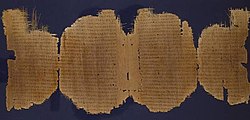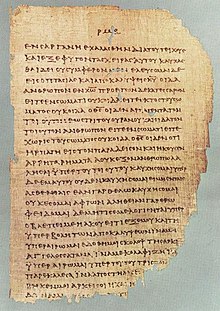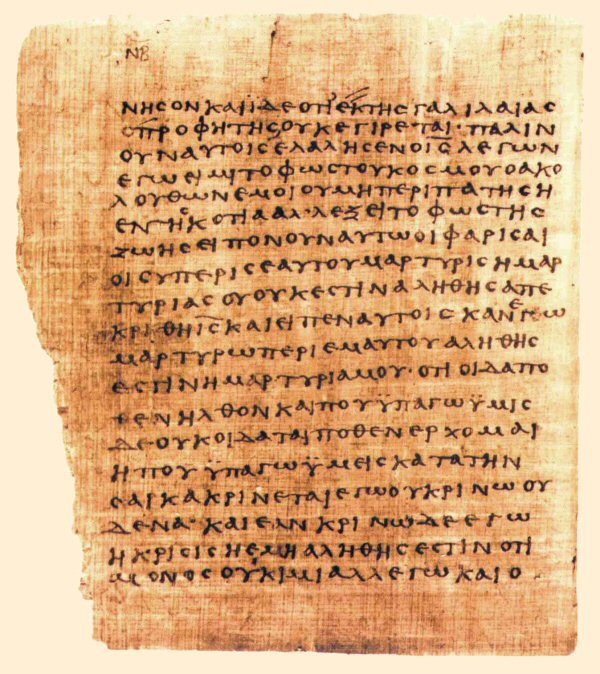Swimmy wrote:Just for for fun. I forwarded this evidence to a angry atheist. If you wish to refute. I'll paste your argument back to him..
2. Josephus Flavius (37-100 AD). A Jewish-Roman historian who wrote various passages about Christ. His supposed sorcery, his death and resurrection, and his brother James and John the Baptist.
Wrong. There are only TWO such mentions, both very brief and interrupting the flow of the narrative, and they are both later Christian interpolations.
You can tell this person that he is spectacularly wrong. In the 90s AD Josephus wrote a broad history of the Jewish people, Jewish [Antiquities]. Josephus' writings cover a number of figures familiar to any Christian who reads his bible. He discusses John the Baptist, James the brother of Jesus, Pontius Pilate, the Sadducees, the Sanhedrin, the High Priests and the Pharisees. As for Jesus, there are two references to him in [Antiquities]. First, the extant texts refer to Jesus and his ministry. This is known as the Testimonium Flavianum:
"Now there was about this time Jesus, a wise man, if it be lawful to call him a man, for he was a doer of wonderful works, a teacher of such men as receive the truth with pleasure. He drew over to him both many of the Jews, and many of the Gentiles. He was the Christ, and when Pilate, at the suggestion of the principal men among us, had condemned him to the cross, those that loved him at the first did not forsake him; for he appeared to them alive again the third day; as the divine prophets had foretold these and ten thousand other wonderful things concerning him. And the tribe of Christians so named from him are not extinct at this day."
Jewish Antiquities 18.3.3
According to one of the leading scholars on Jopsephus, Louis Feldman, the authenticity of this passage "has been almost universally acknowledged" by scholars. (Louis Feldman, "Josephus," Anchor Bible Dictionary, Vol. 3, pg 990-91).
Here's a reconstruction of what scholars of "partial authenticity" believe the original text of the [TF] would have looked like in book 18:
"At this time there appeared Jesus, a wise man. For he was a doer of startling deeds, a teacher of people who receive the truth with pleasure. And he gained a following among many Jews and among many of Gentile origin. And when Pilate, because of an accusation made by the leading men among us, condemned him to the cross, those who had loved him previously did not cease to do so. And up until this very day the tribe of Christians (named after him) had not died out."
(John Meier, A Marginal Jew, pg 61)
There were almost certainly interpolations to the text. However, scholars are near-unanimous that the text, for the large part, is unmistakably from Joesephus' hand. A few examples:
1. "Now there was about this time Jesus"
The digression and introductory phrase are typical of Josephus.
"The opening phrase 'about this time' is characteristic of his language in this part of [Antiquities], where he is weaving together distinct episodes into a coherent narrative." (Steve Mason, Josephus and the New Testament, pg 171)
2. "a wise man, if it be lawful to call him a man"
The phrase "wise man" is characteristically Josephan; it almost certainly is not a Christian addition. This is followed by the obvious interpolation "if it be lawful to call him a man" This indicates that the interpolator found the description of Jesus as a "wise man" to be woefully inadequate. Sp he remedies this insufficient description of Jesus by clarifying that there is good reason to doubt he was just a man. A Christian scribe would not deny that Jesus was wise, but would certainly feel it to be insufficient since Jesus was God.
"As it stands, the reticence to call Jesus a man seems like a rejoinder to the previous, already flattering statement that he was a wise man. It seems more like a qualification of an existing statement than part of a free creation." (Mason, ibid)
3. "for he was a doer of wonderful works"
Mason confirms that the term "startling/incredible deeds" (paradoxa) is Josephan: "Josephus often speaks of “marvels” and “incredible” things in the same breath, as the testimonium does. He even uses the phrase rendered “incredible deeds” in two other places, once of the prophet Elisha (Ant. 9.182; cf. 12.63)." (Mason, ibid)
4. "a teacher of such men as receive the truth with pleasure"
The phrase "receive the truth with pleasure" is again characteristically Josephan.
"In particular, Thackeray, the prince of Josephan scholars, who went so far in his study of Josephus' language as to compose a lexicon to Josephus for his own use so as to see how precisely each word is used in Josephus and whether there is evidence of shifts of style in various parts of his works due to his "assistants" or to other reasons, noted that the phrase 'such people as accept the truth gladly' is characteristic of the scribe in this part of the [Antiquities], since the phrase appears eight times in books 17-19 (supposedly the work of the Thucydidean assistant) and nowhere else in Josephus."
(Louis Feldman, The Testimonium Flavianum, The State of the Question, Christological Perspectives, Eds. Robert Berkley and Sarah Edwards, pg 188).
--------------------------------------------------------------------------------------------------------------------------------------------------------------------------------------------
Second reference:
"But the younger Ananus who, as we said, received the high priesthood, was of a bold disposition and exceptionally daring; he followed the party of the Sadducees, who are severe in judgment above all the Jews, as we have already shown. As therefore Ananus was of such a disposition, he thought he had now a good opportunity, as Festus was now dead, and Albinus was still on the road; so he assembled a council of judges, and brought before it the brother of Jesus the so-called Christ, whose name was James, together with some others, and having accused them as lawbreakers, he delivered them over to be stoned."
Jewish Antiquities 20.9.1
The validity of Josephus' reference to James' Martyrdom increases the likelihood that the [TF] is also valid. In the reference to James, he refers to Jesus as "the so-called Christ" without further explanation. Because the reference to Jesus is likely meant to specify which James Josephus was discussing, it is probable that Josephus had already explained to his audience the significance of Jesus, hence "the so-called Christ."
"Within Josephus' narrative, this phrasing is best explained by his wish to recall his earlier reference to Jesus (Ant. 18.63—64), thus: “this man was the brother of the one I mentioned before.” It might also be that Josephus means to indicate something of the accusations brought against James: just as his brother was condemned by some Jewish leaders, so also James ran afoul of Ananus. But if Josephus did not think James' actions worthy of death, that might support the view that the original form of the testimonium was similarly mild."(Mason, ibid)
Liberal commentators such as Robert Funk, J. Dominic Crossan, and A.N. Wilson, accept a substantial part of the TF as originally Josephan; Jewish scholars such as Geza Vermes, Louis H. Feldman, and Paul Winter; secular scholars such as E.P. Sanders and Paula Fredrikson. Even Jeff Lowder, co-founder of the Secular Web, recognizes the merits of the partial authenticity theory. [Lowder, Josh McDowell's Evidence for Jesus: Is it Reliable? 2000]. Paula Fredrikson sums up the state of the question among scholars: "Most scholars currently incline to see the passage as basically authentic, with a few later insertions by Christian scribes." (Jesus of Nazareth, King of the Jews, page 249).
Practically the only scholars disagreeing with this are Jesus Mythologists; kinda tell a story in itself ...
Swimmy wrote:Etc. etc. etc., yadda yadda yadda - you got *nothing*. Stuff decades and centuries after the supposed events, written by people who weren't even born yet at the time the supposed events supposedly took place.
Sources for Jesus date to within 20 years of his death. Ask this person if he's read Bart Ehrman, who dates Paul's writings to the early 50s AD. ask him if he accepts that Plato lived? That Aristotle lived? That Socrates lived? If he does, then inform him that these three joined together would not account for even HALF of the evidence that we have for Jesus' existence.
Swimmy wrote:Why can you not find a single source LIVING AND WRITING IN JERUSALEM DURING THAT TIME who mentions your jesus? We have plenty of extant texts from that time/place
Um, tell him that he should take an objective look at the evidence. Tell him that his source is historically deficient. Tell him that, if he wishes to know the truth, not to rely only on sources who start out with a predisposition and an agenda. Then he may get somewhere.














